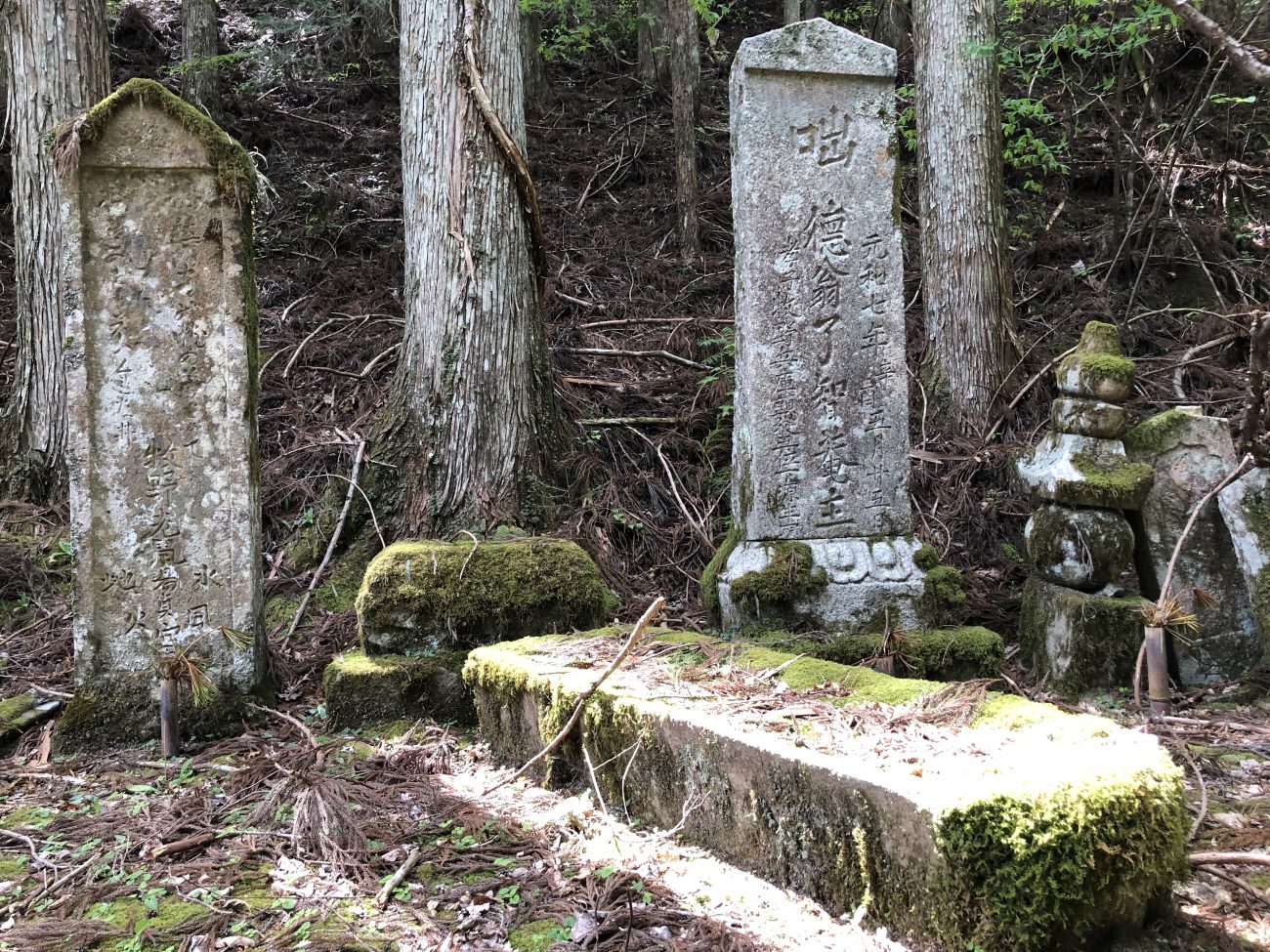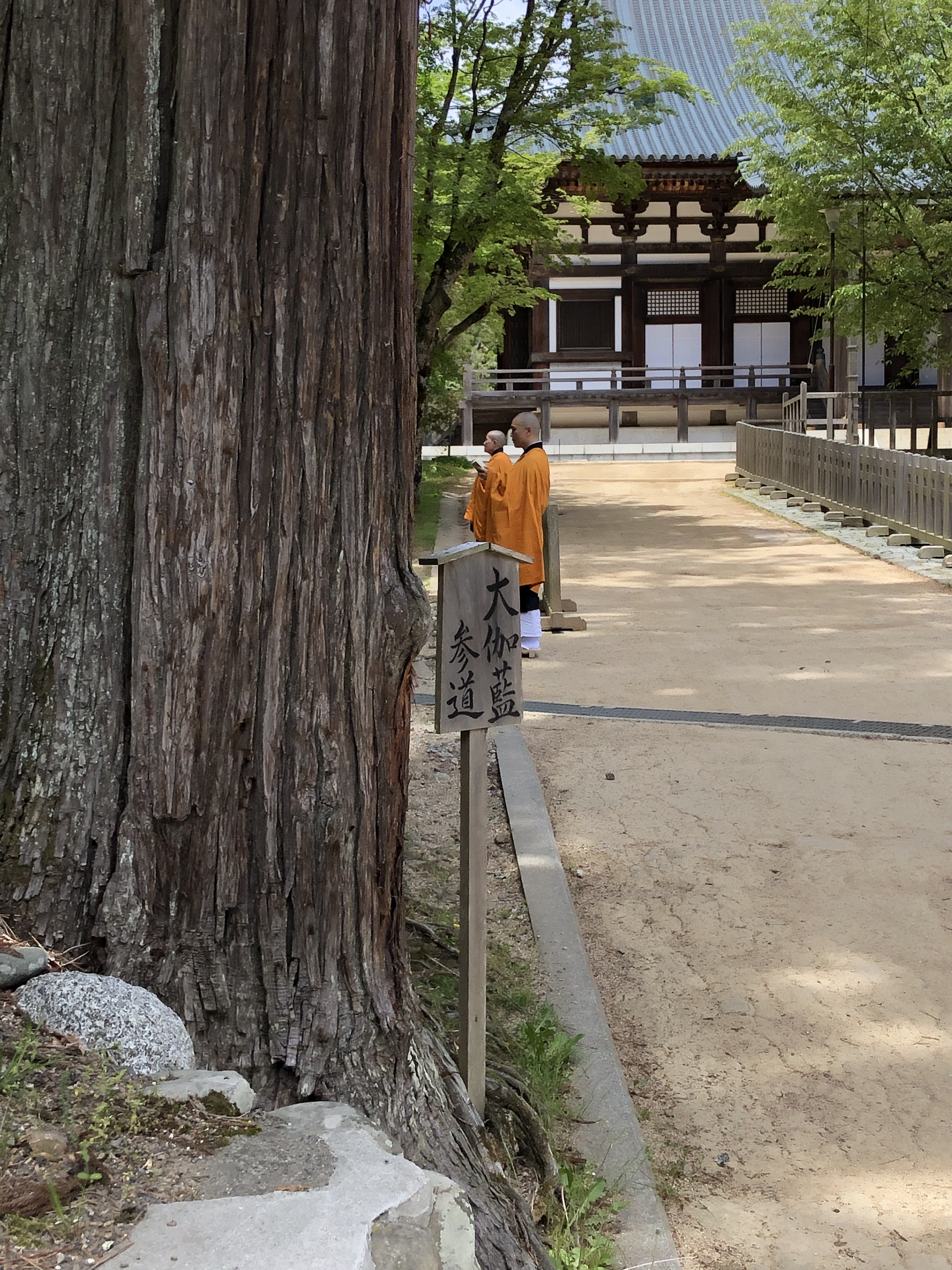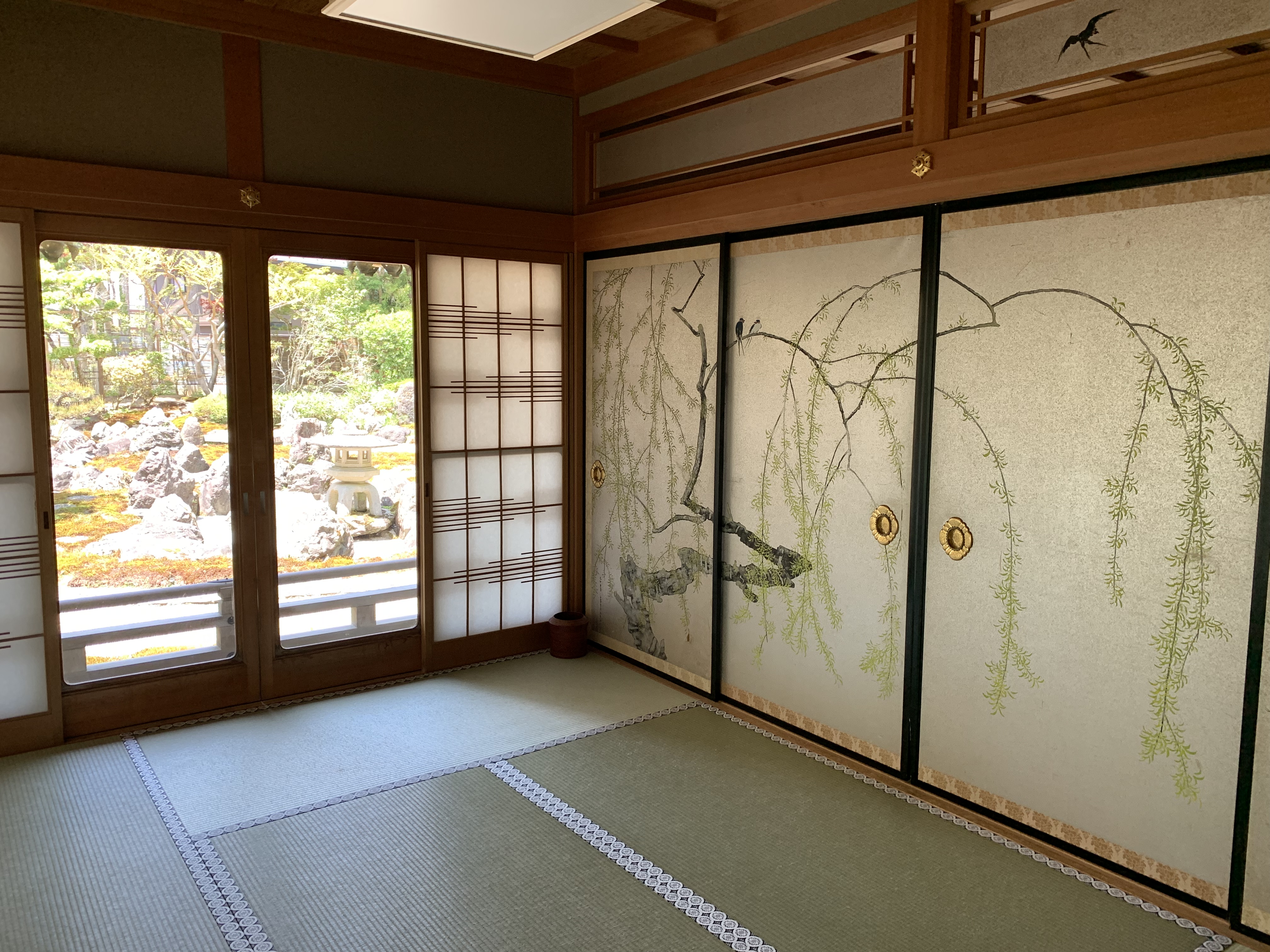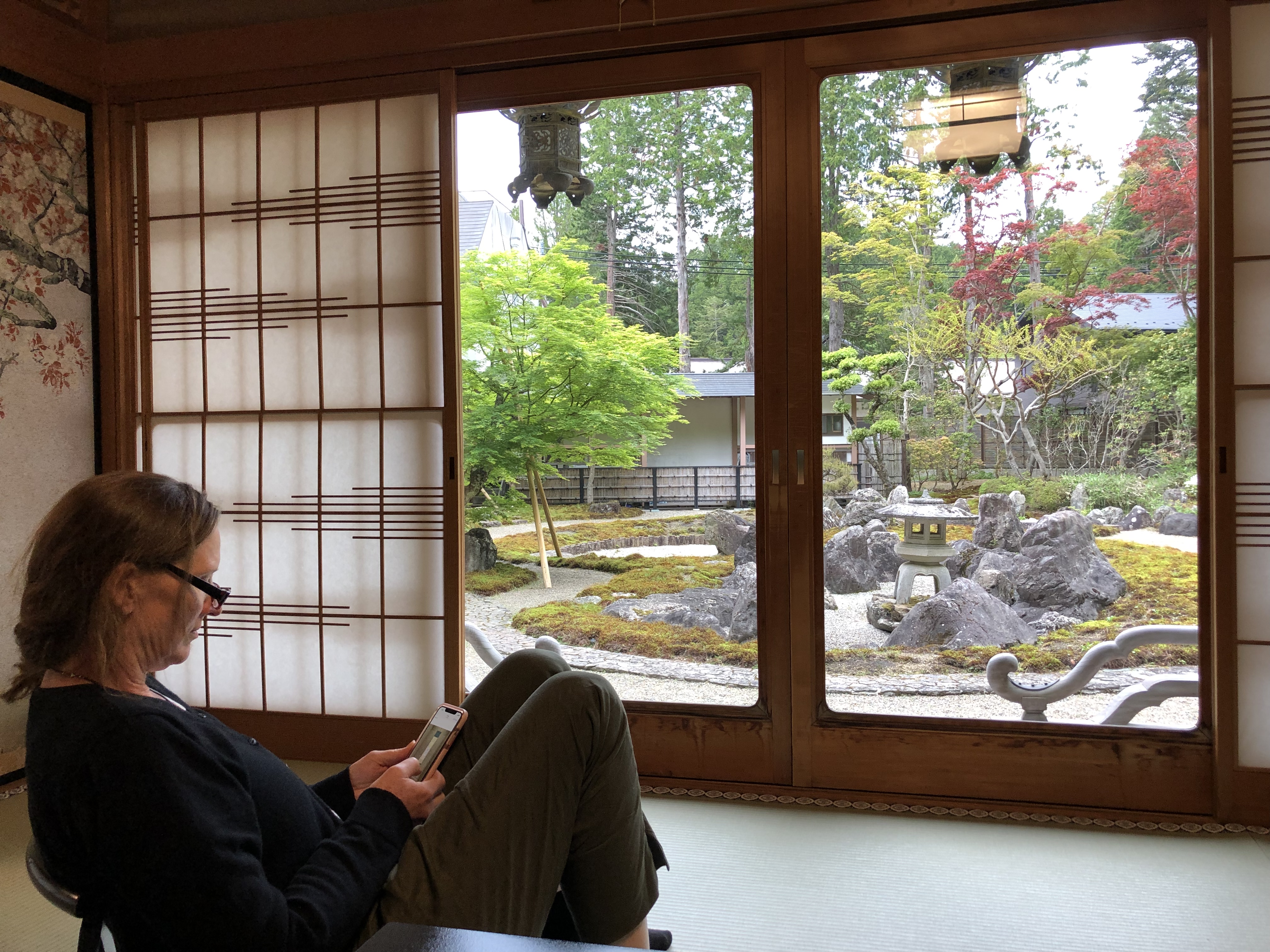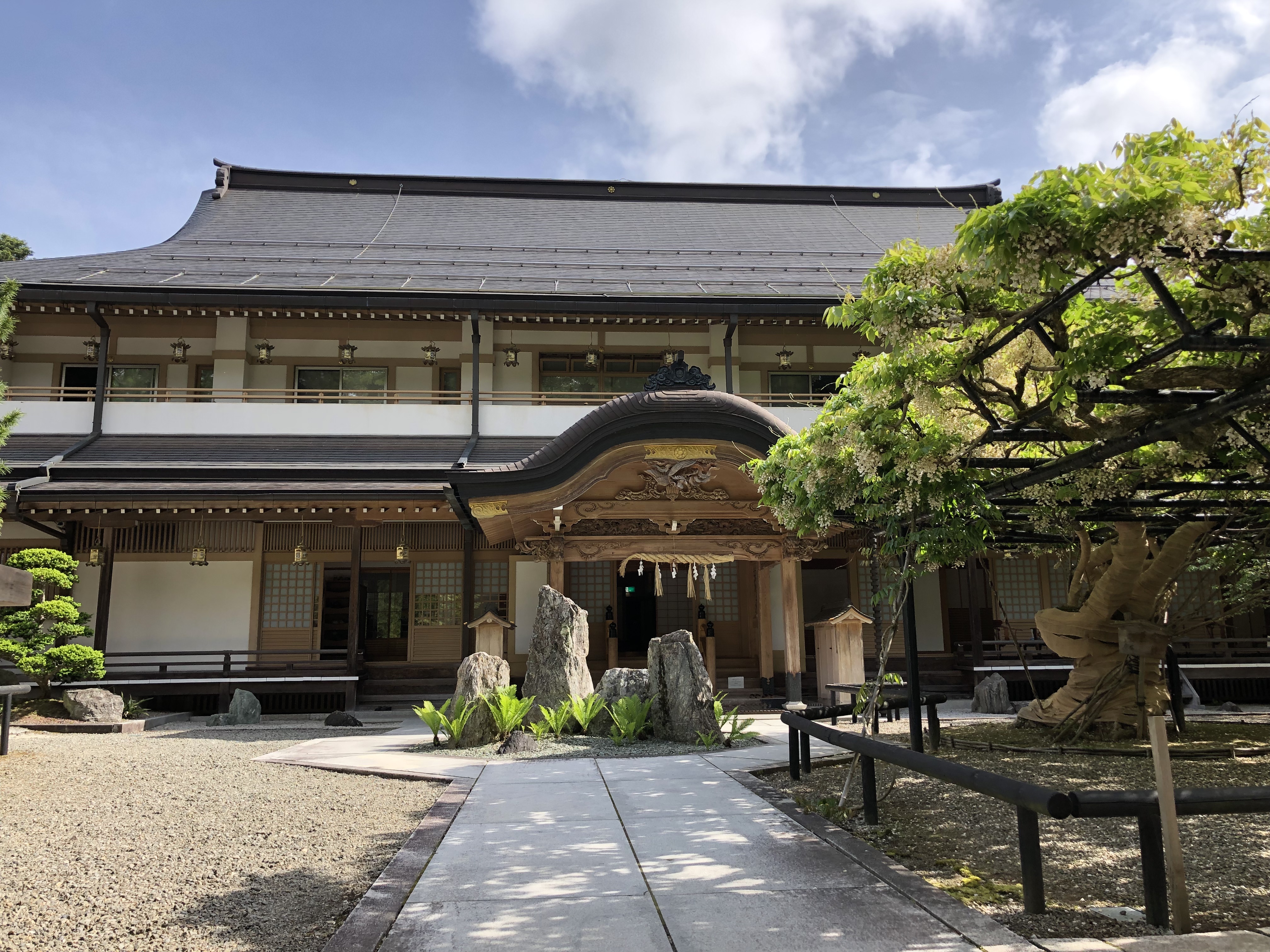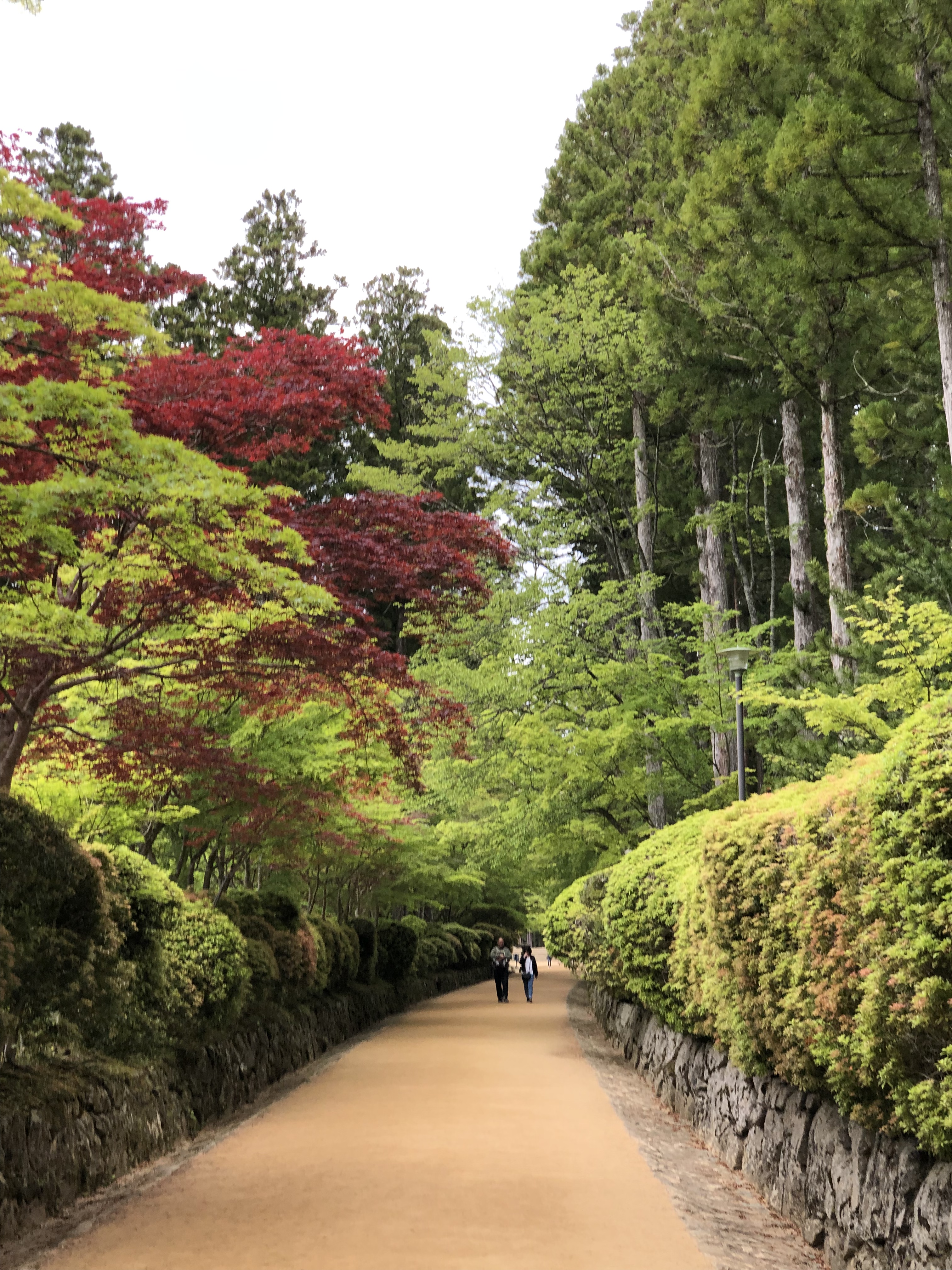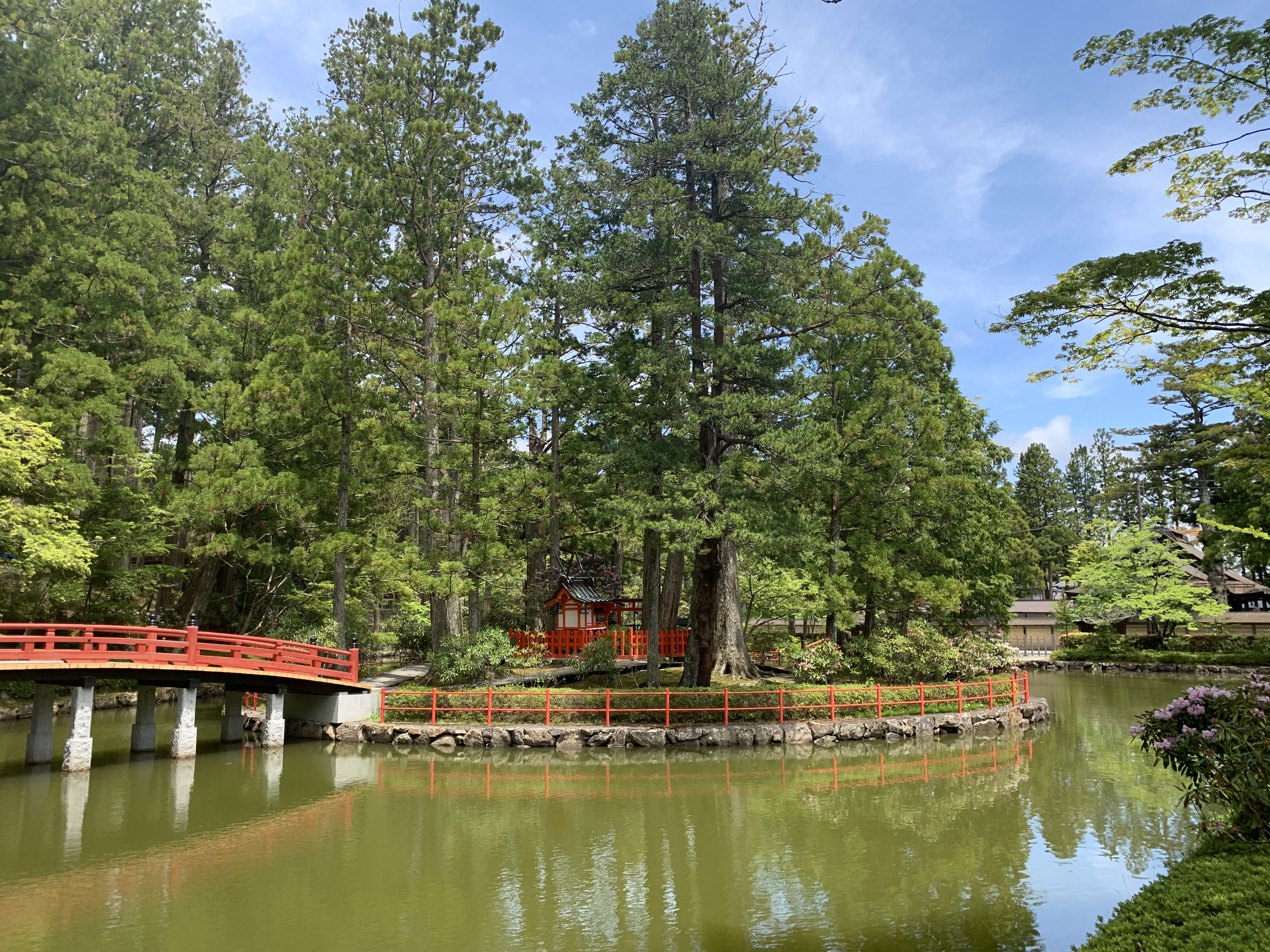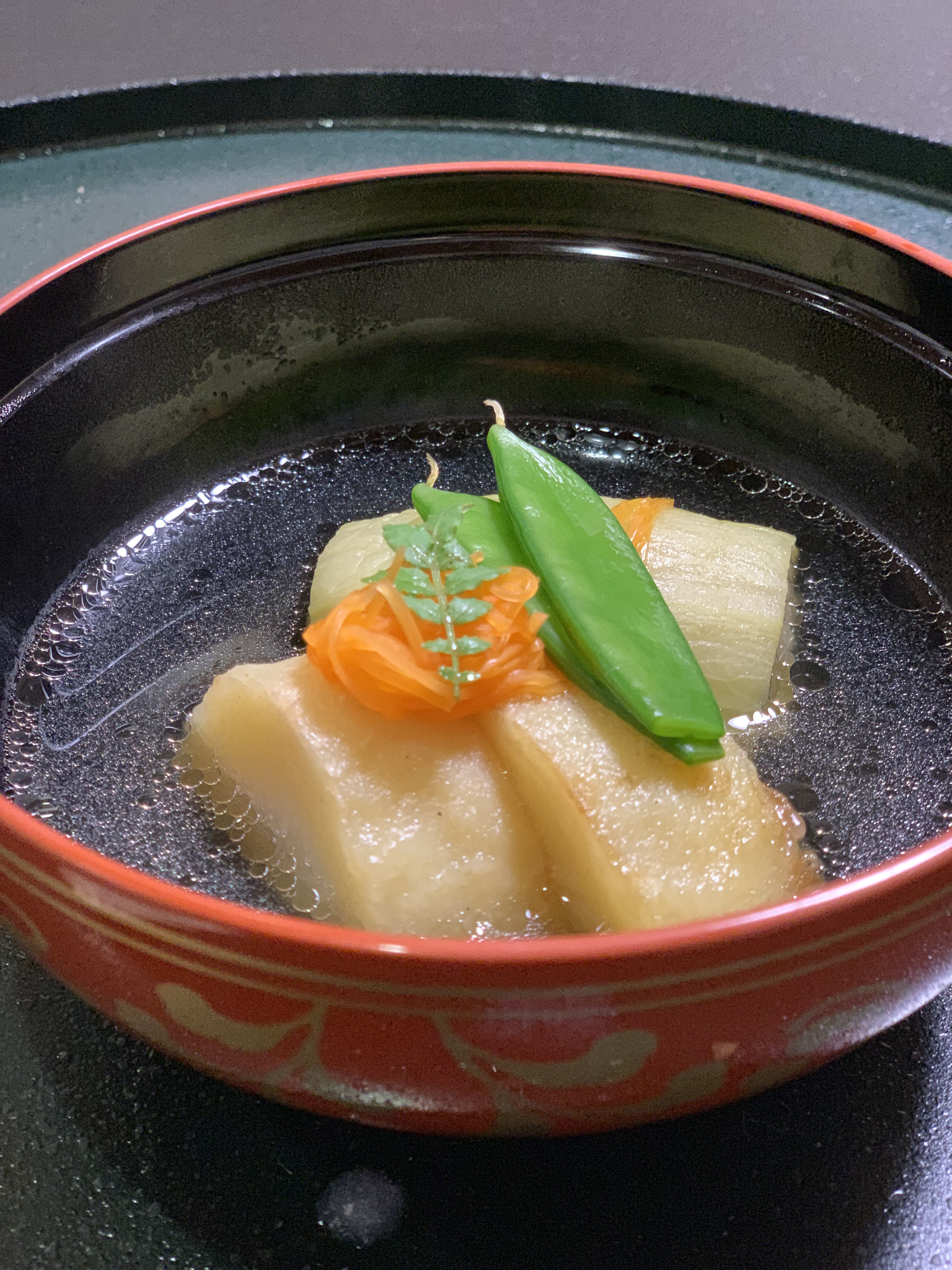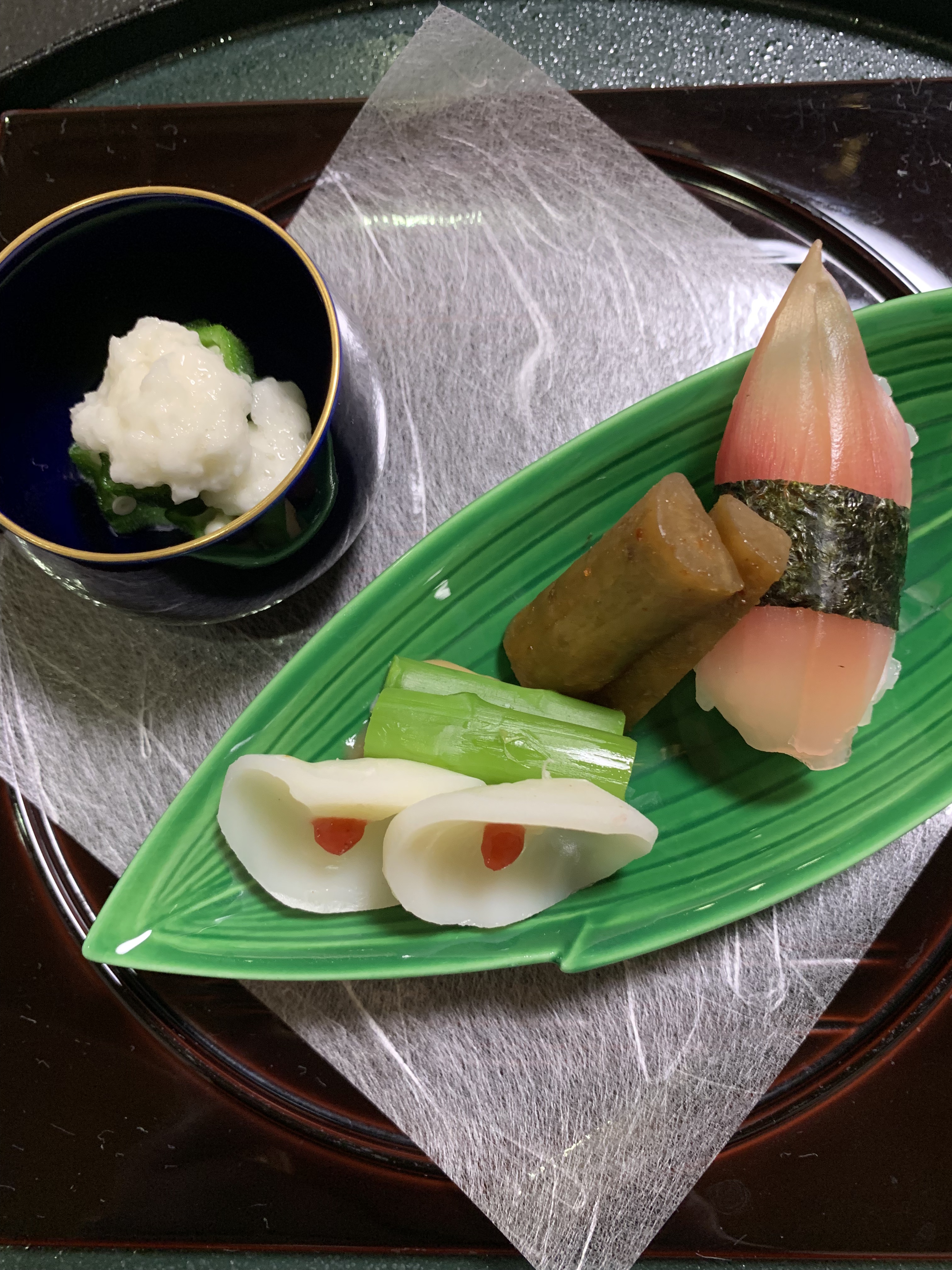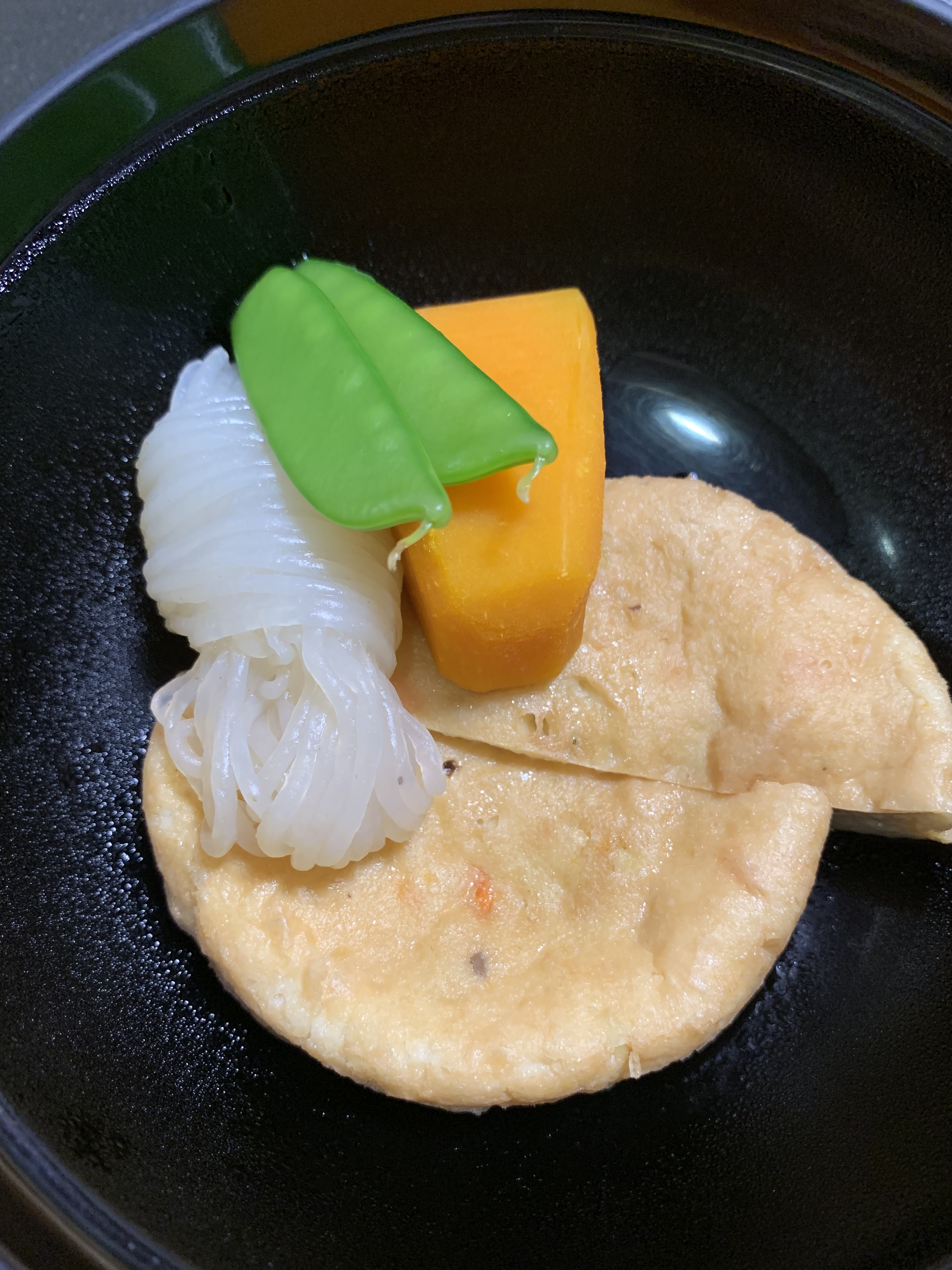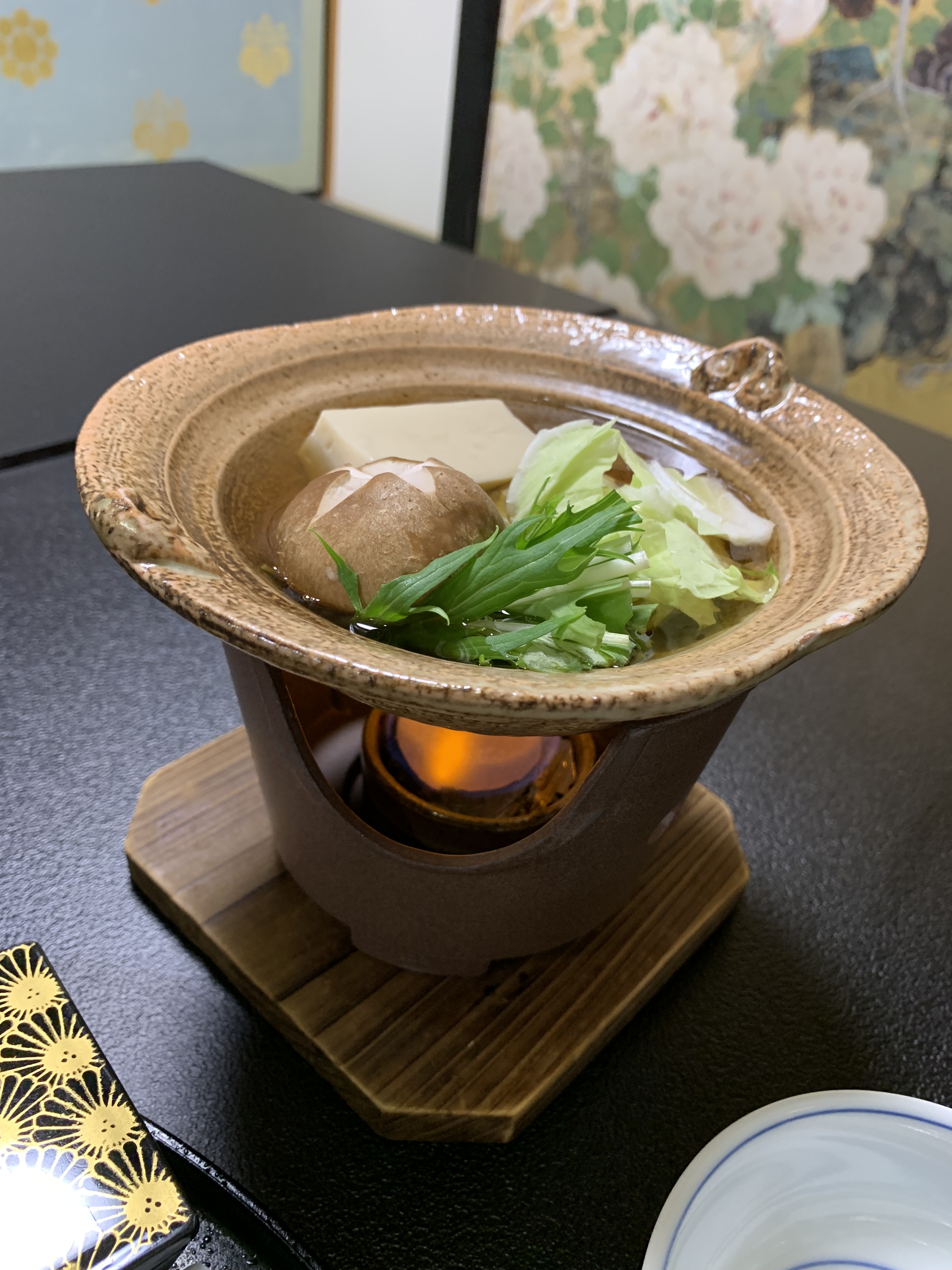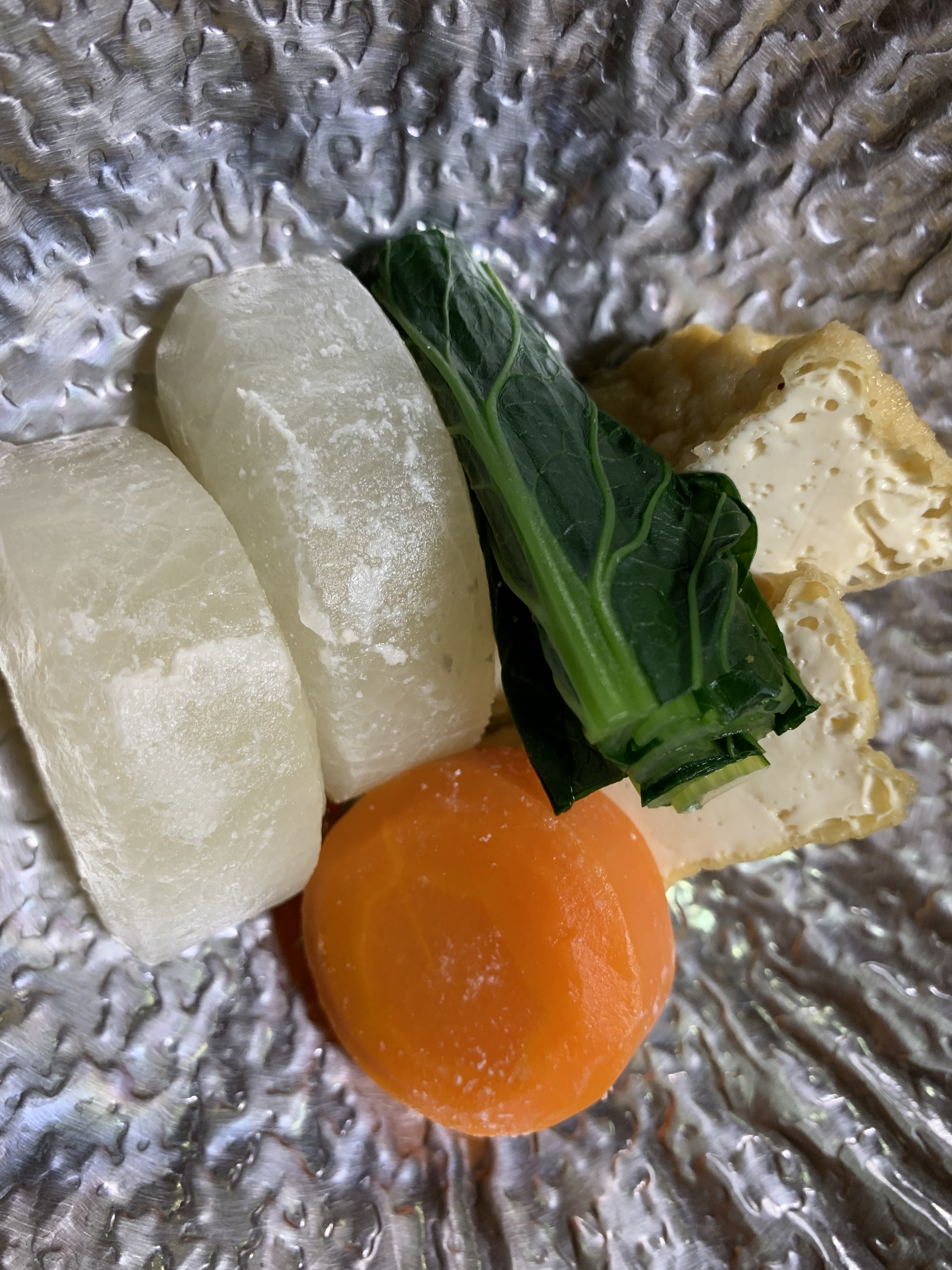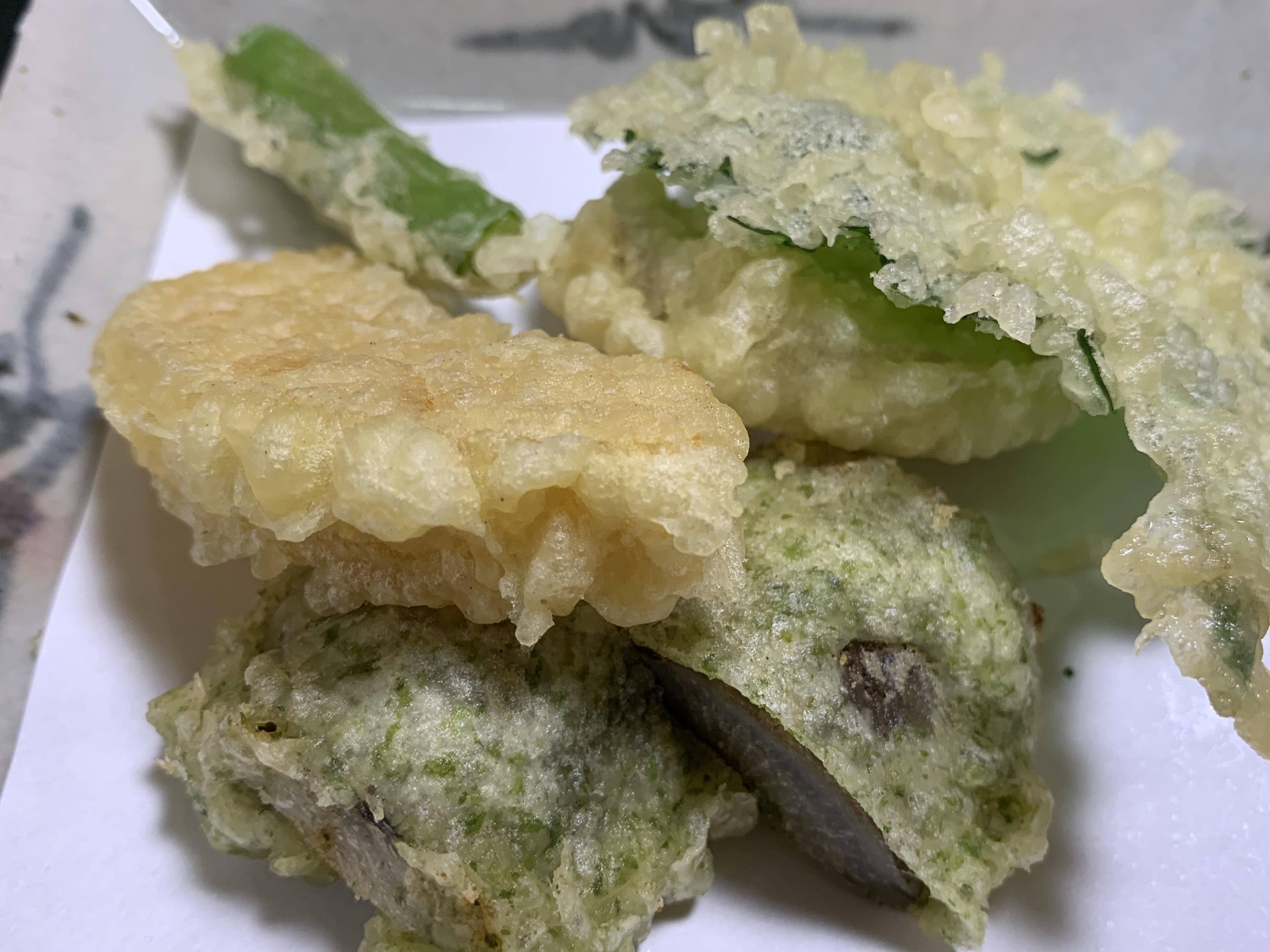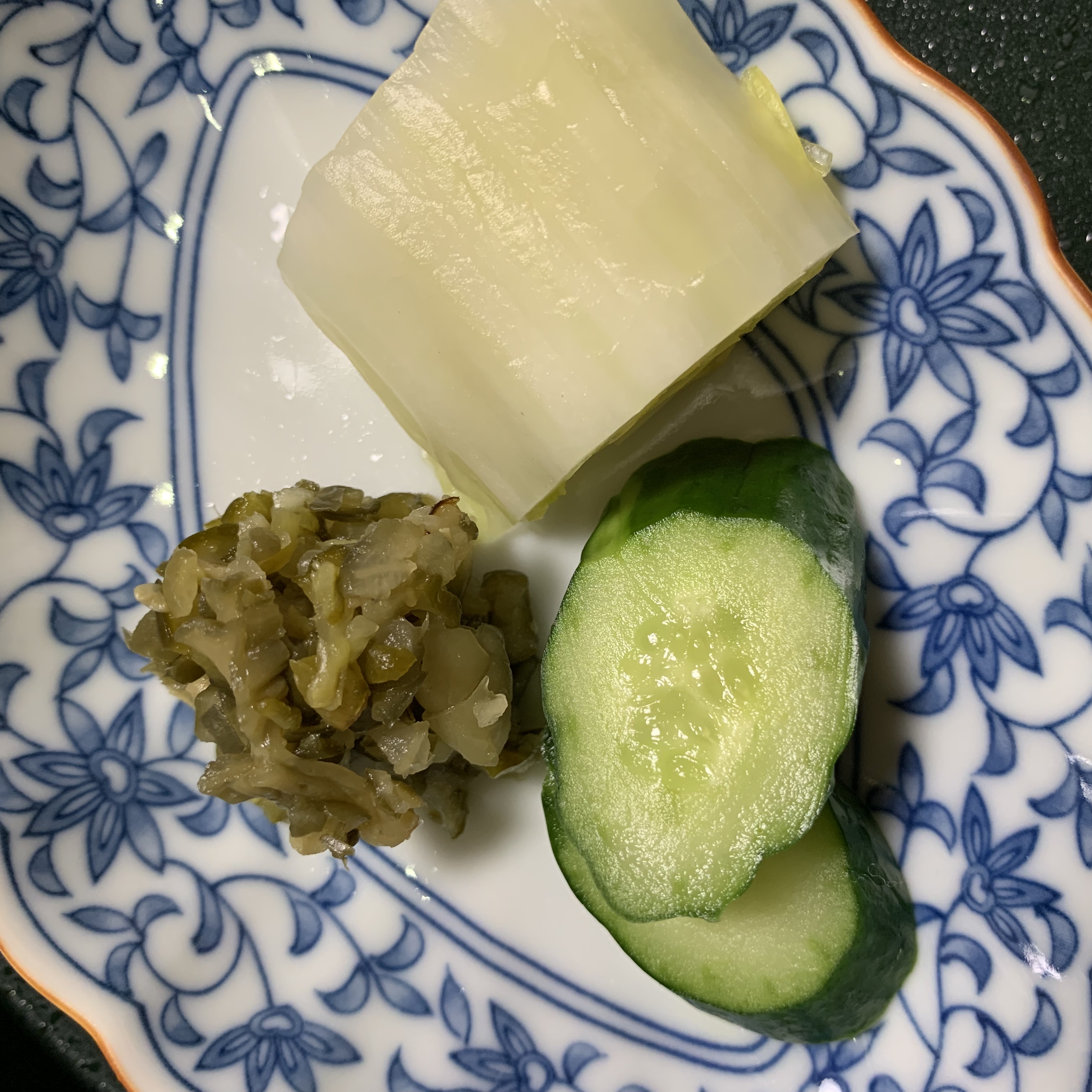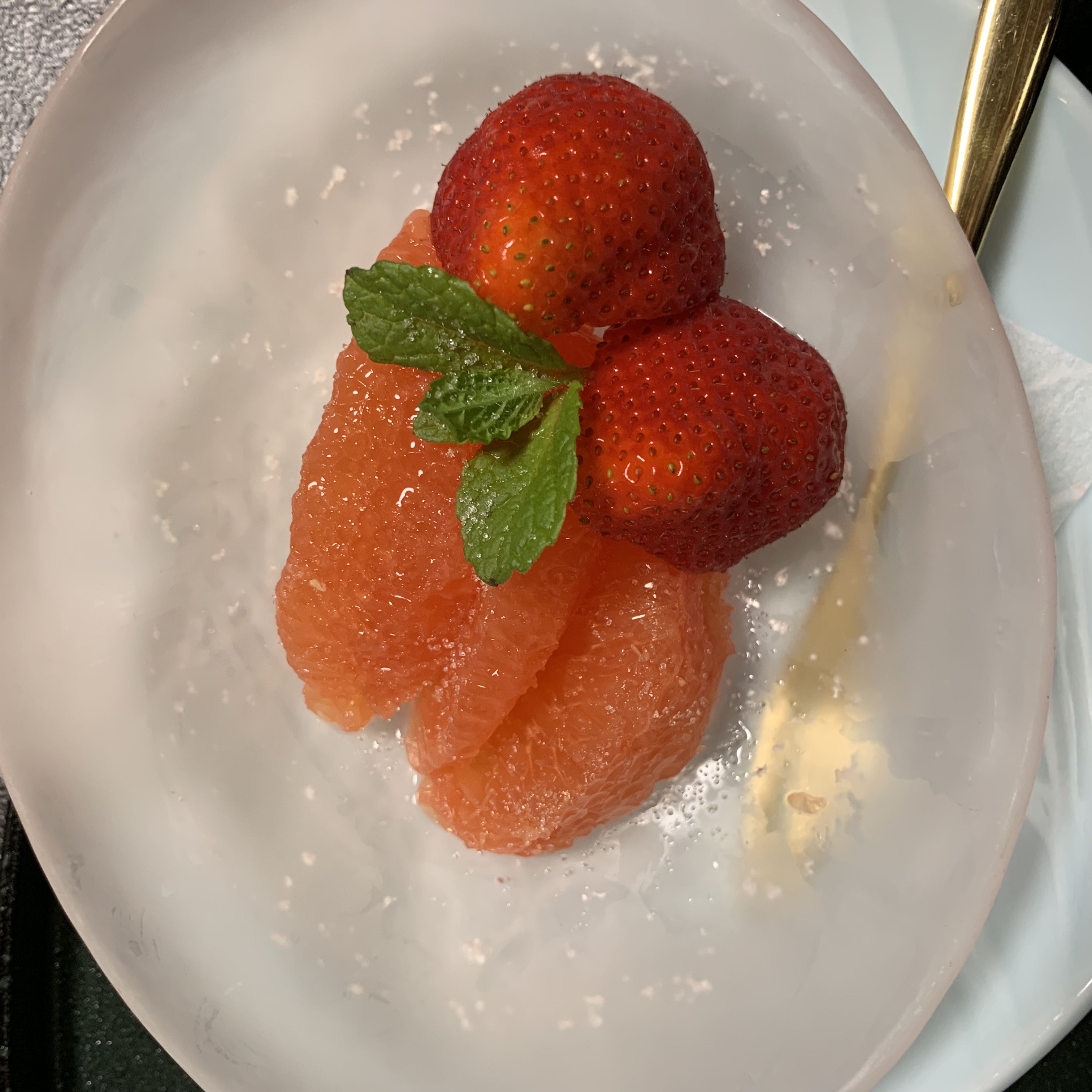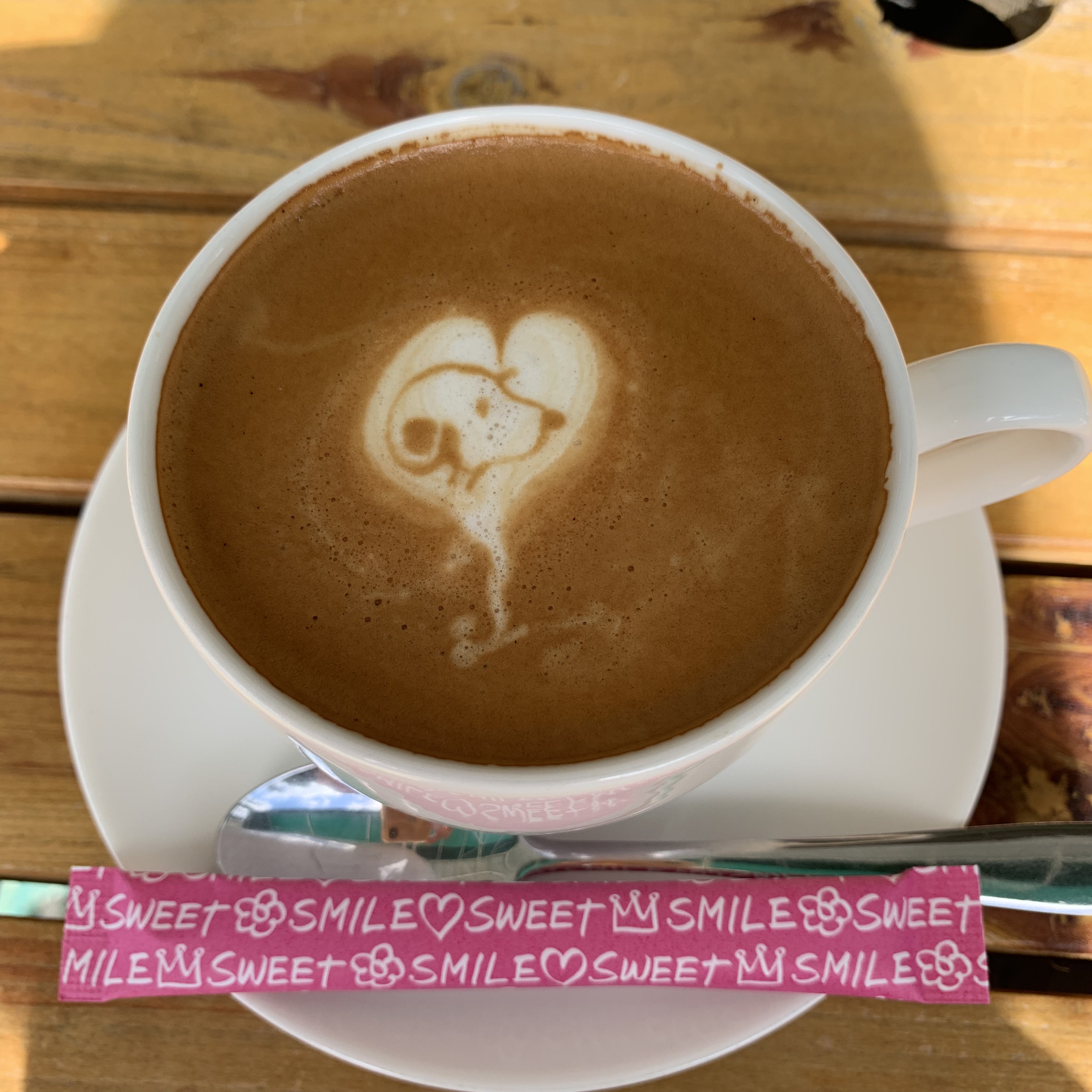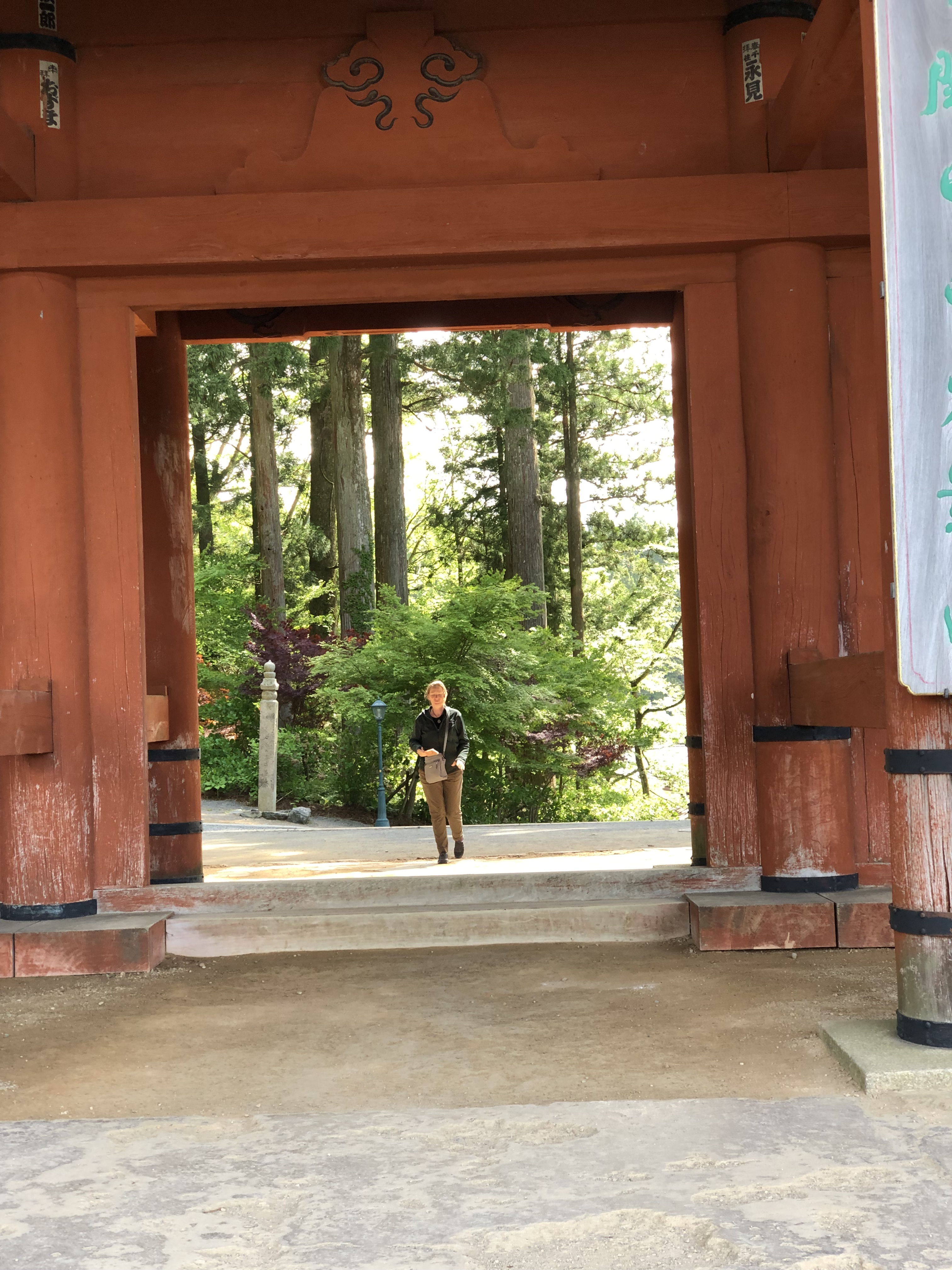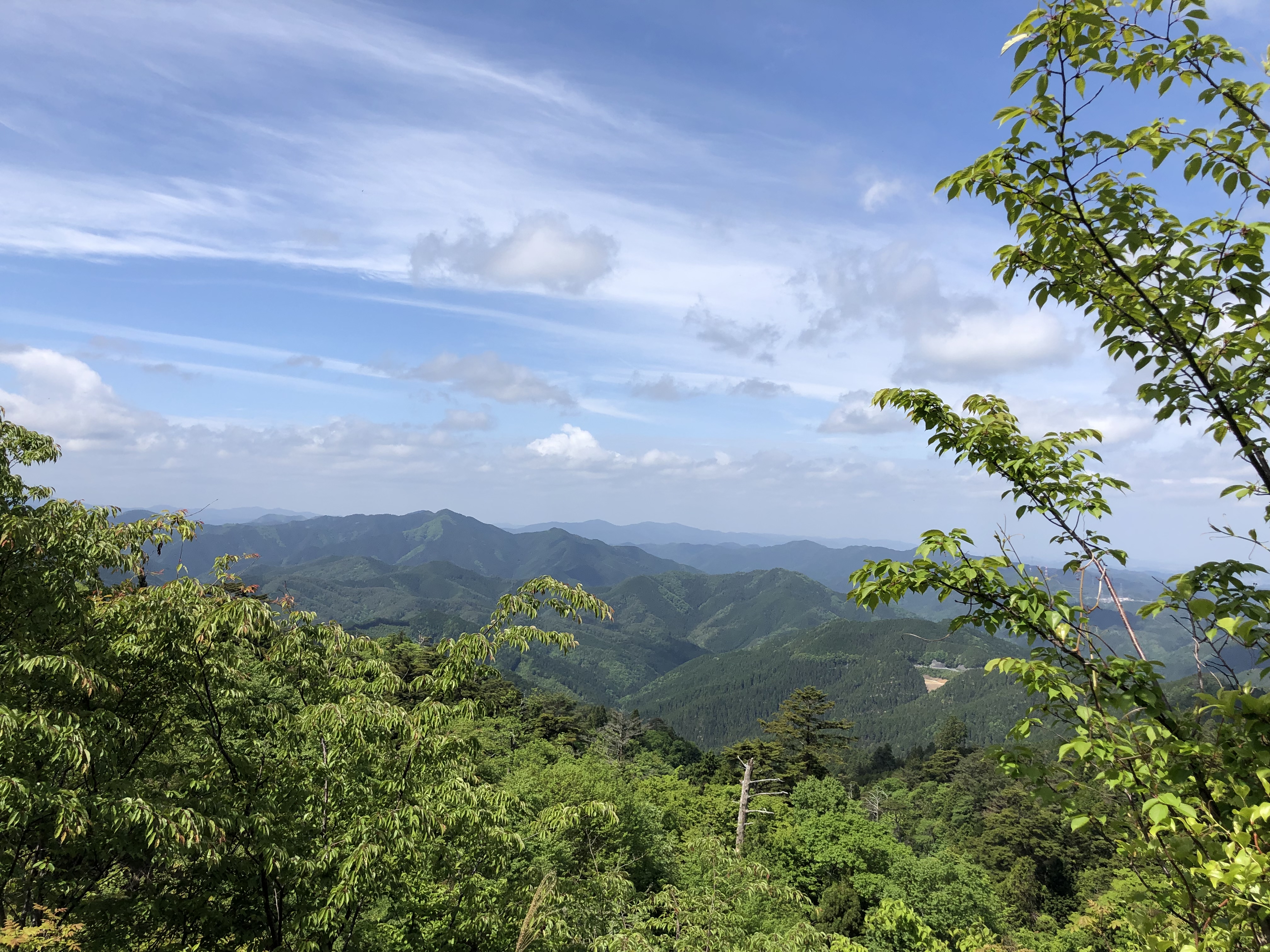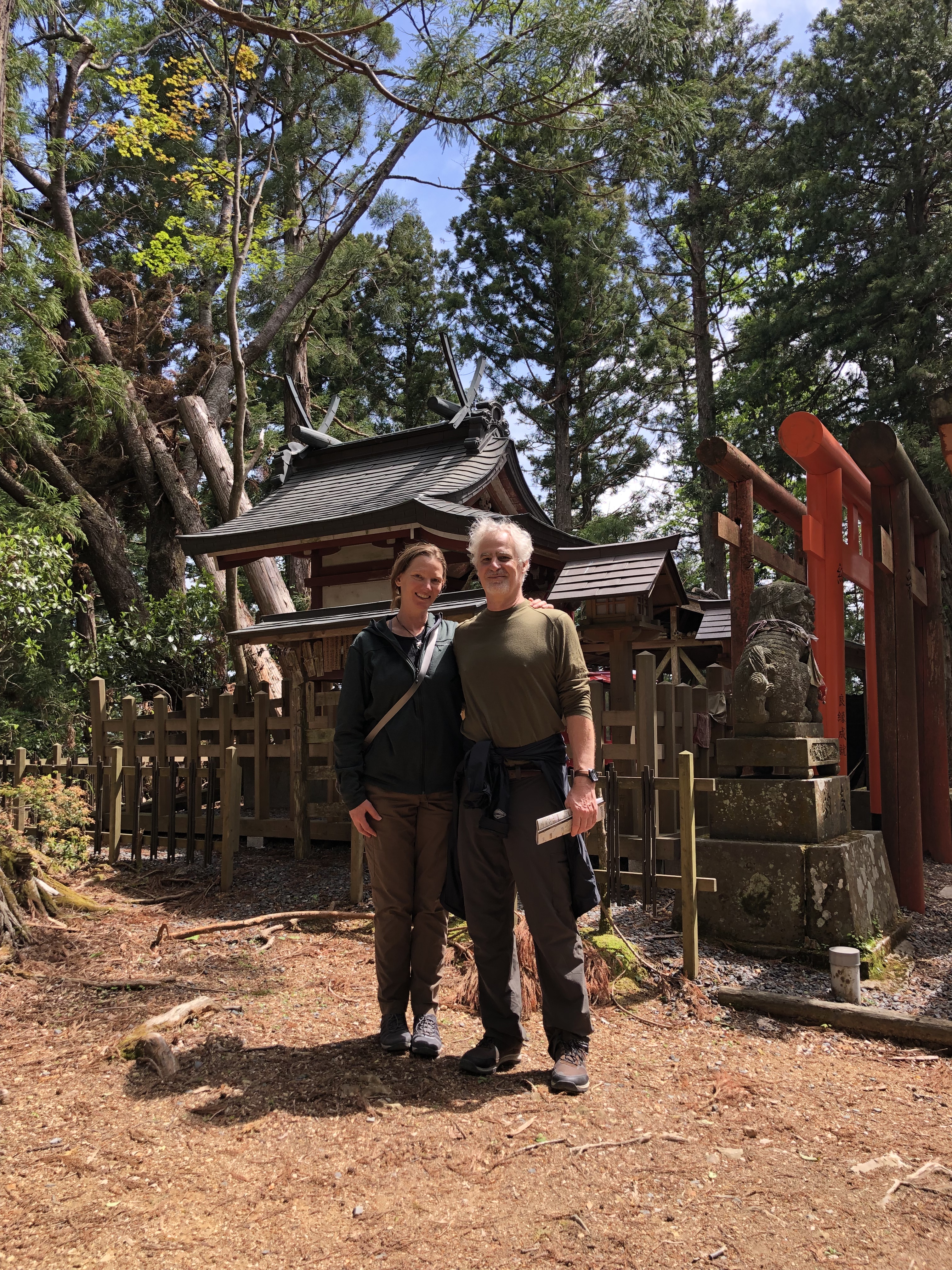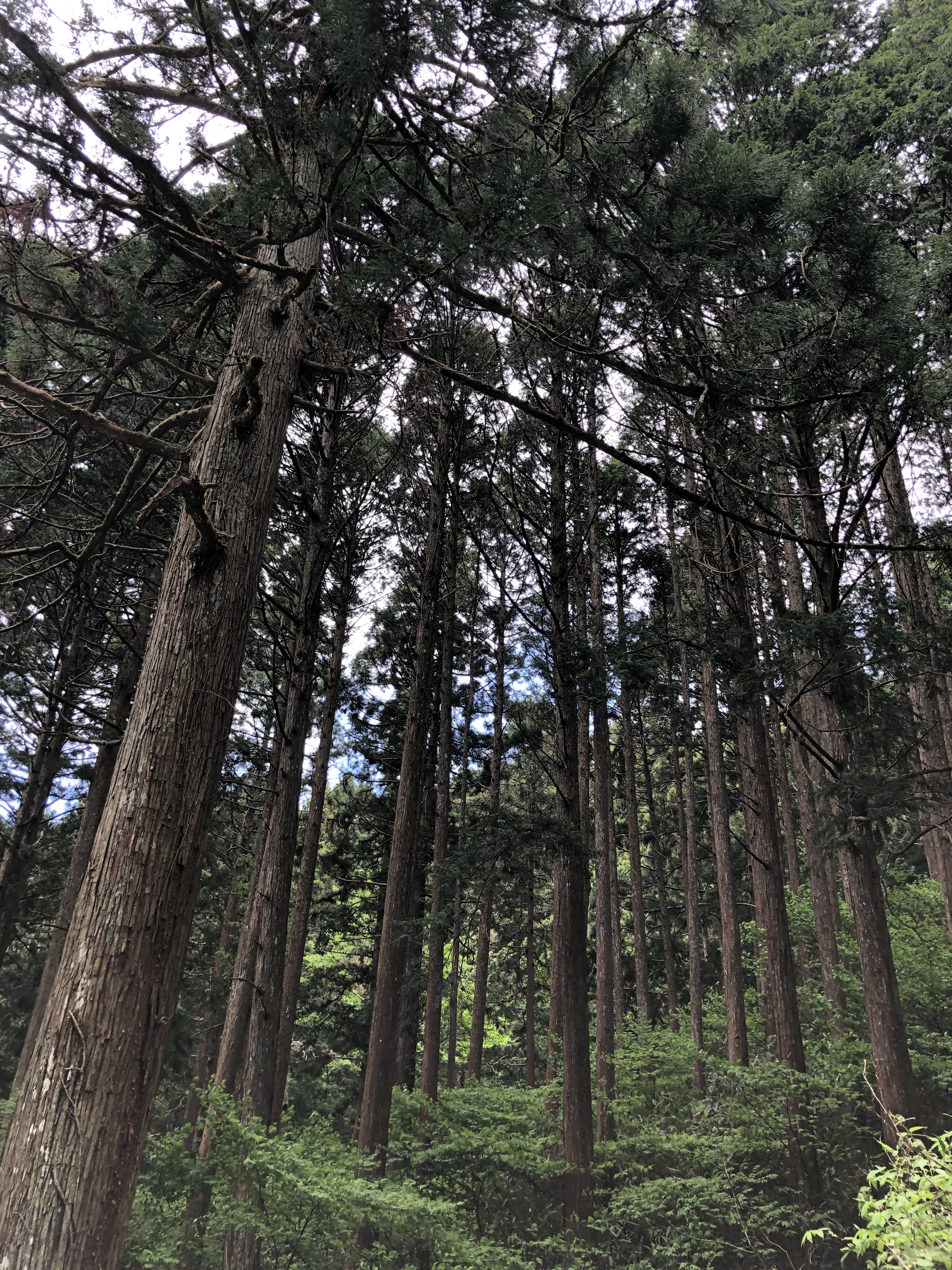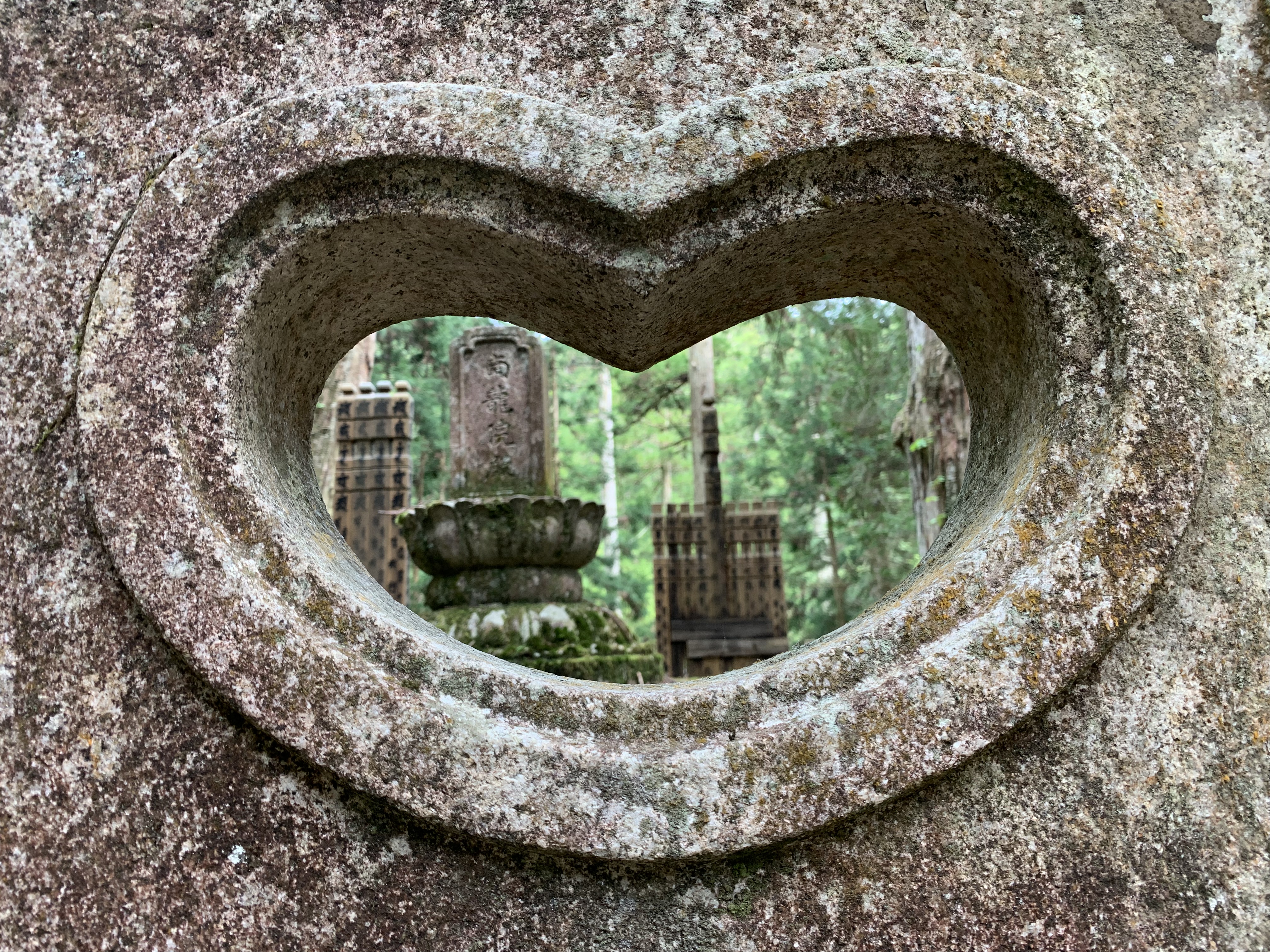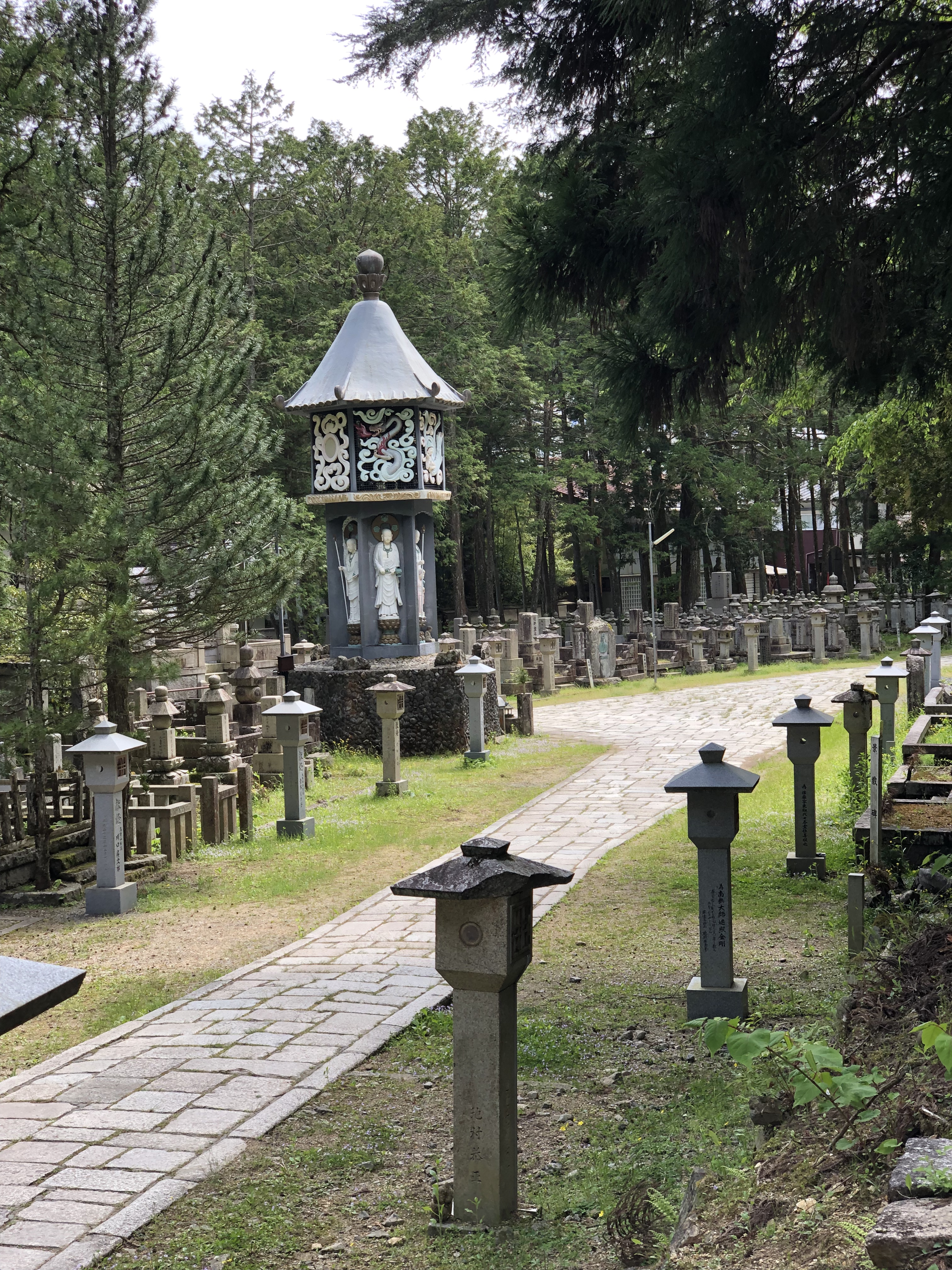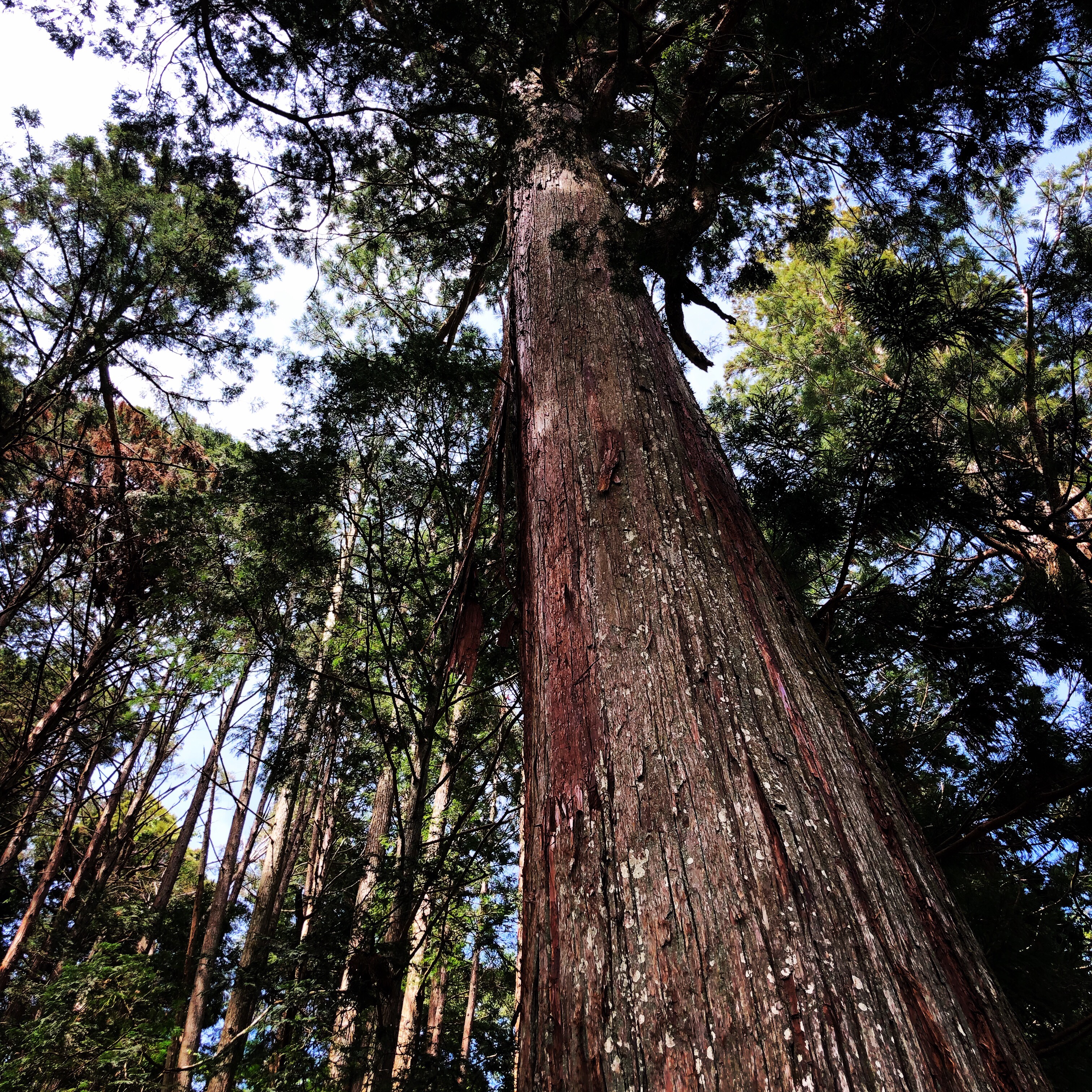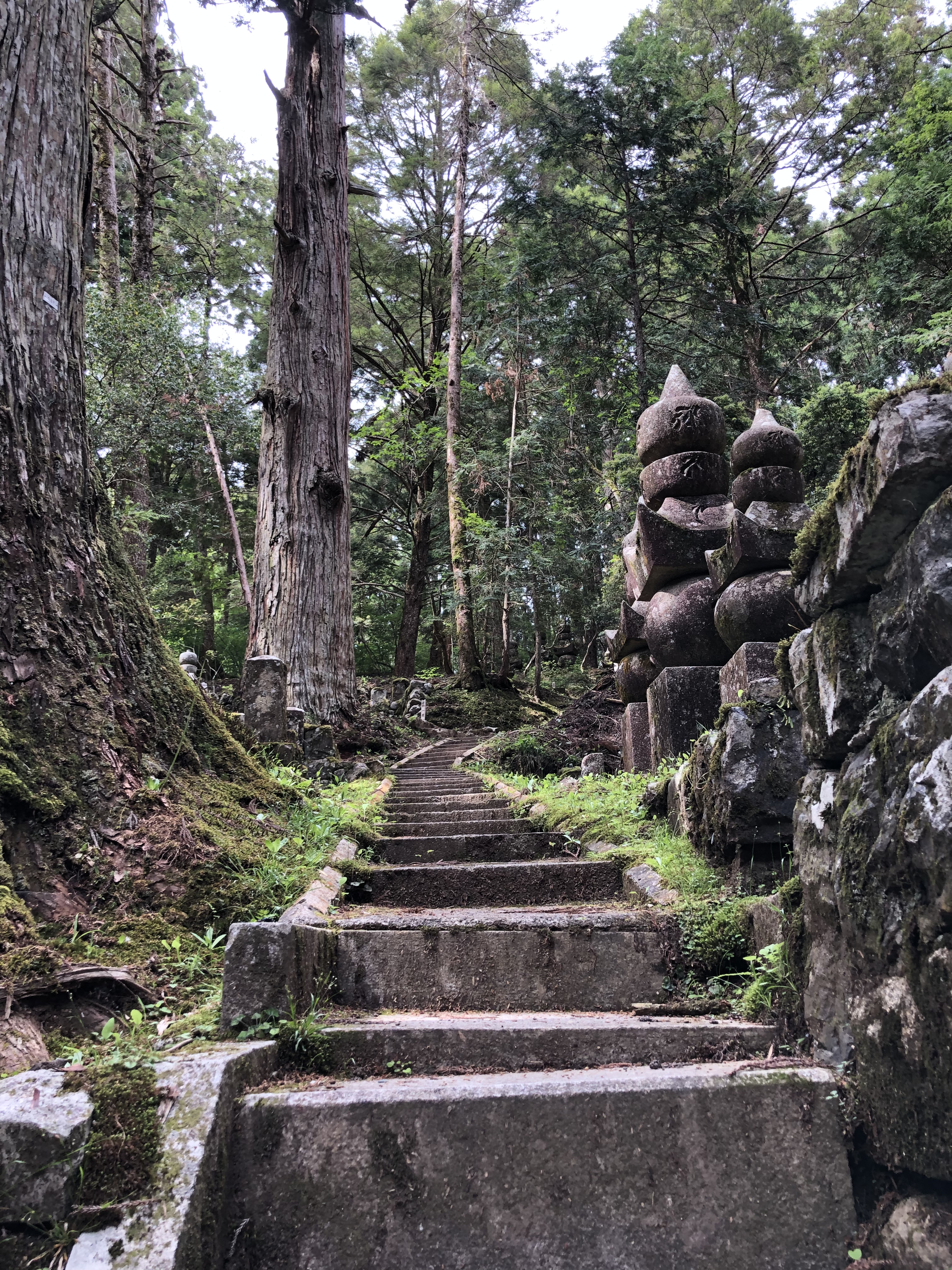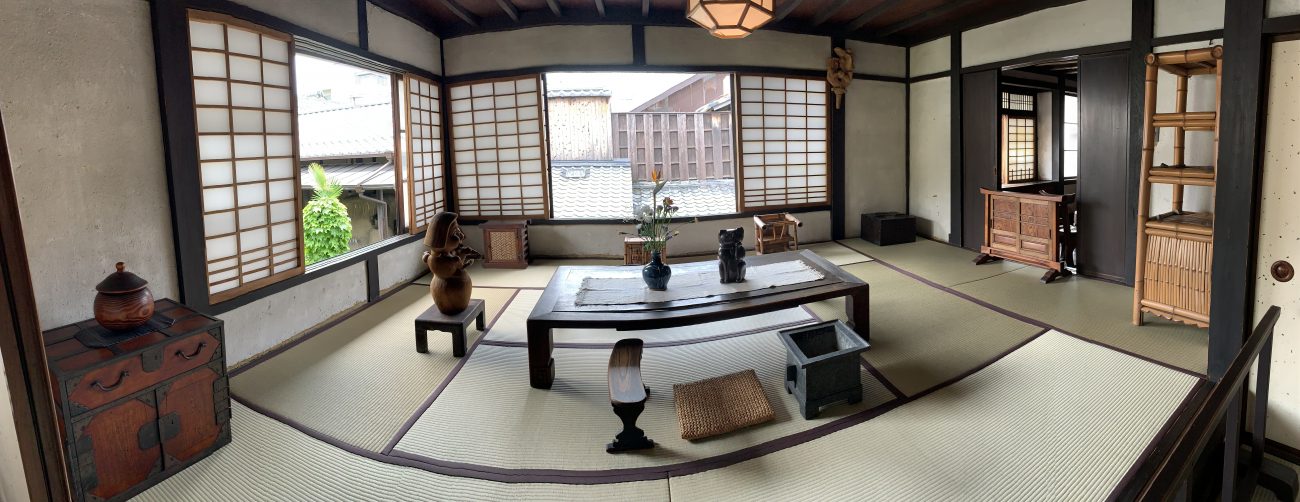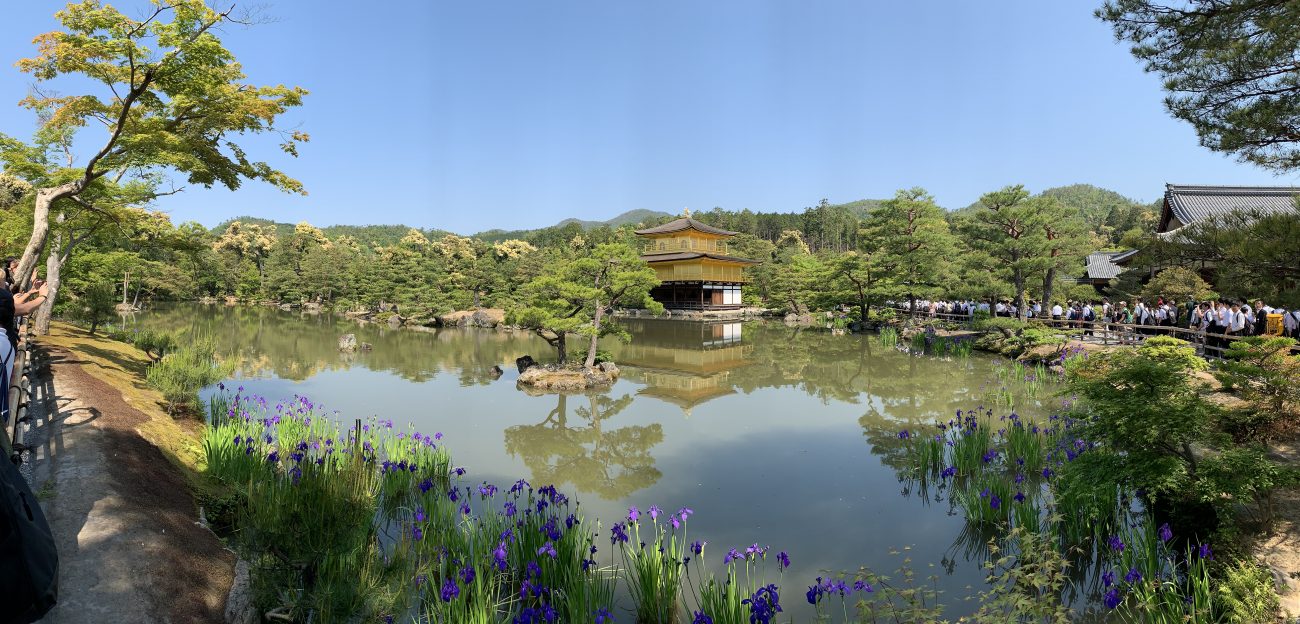The secluded temple town of Koyasan has a long history as a sacred place, beginning in the early ninth century when Kobo Daishi wandered Japan in search of a suitable place to build a center for the religion he had founded, Shingon Buddhism. After years of searching, he settled on the wooded top of Mt. Koya and in 826 began construction of the original Garan complex. Today you can find more than a hundred temples here.
Many temples in Koyasan invite guests to stay overnight, and we stayed two nights in Souji-in, known for some of the finest vegetarian cuisine. We had spacious rooms, secluded in the back of a newer wing of the temple, a serene view of the gardens, and a bathroom that took up three rooms, including one with a wooden Japanese soaking tub. As is typical in traditional Japanese lodging, when we went to dinner, they had moved our table aside and laid out our futons for sleeping.
We explored part of the town before dinner, wandering down a scenic path, finding a red wooden bridge and then exploring the Garan complex, the first monastic complex entirely dedicated to the teaching and practice of Shingon Buddhism.
It includes the Kondo Hall, a large wooden temple hall where major ceremonies are held, and Konpon Daito (great Fundamental Pagoda), the tallest building in Koyasan. Completed in 876, it’s an early form two-storied pagoda and a symbol of Koyasan, a town we discovered was filled with a peaceful beauty.
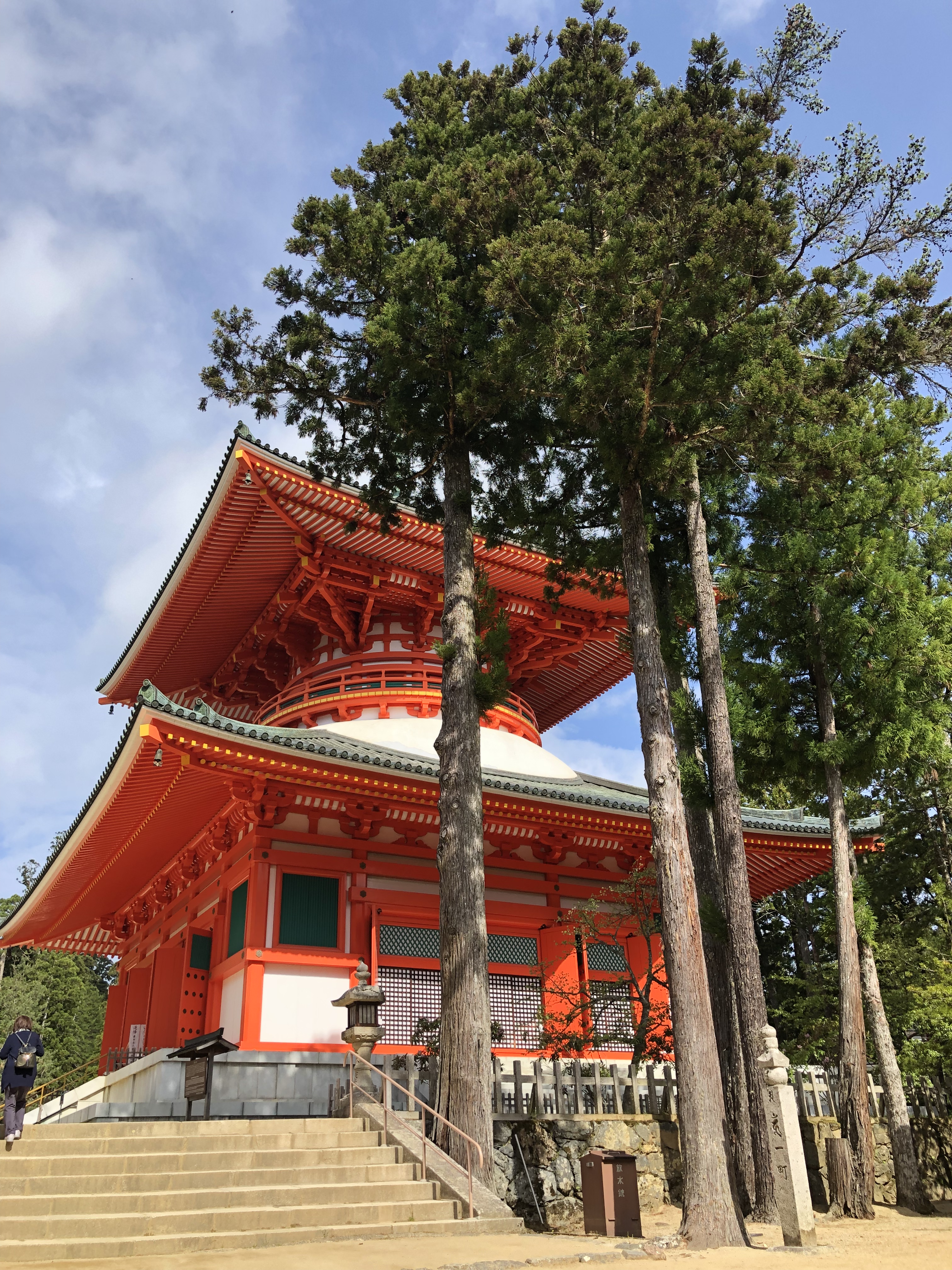
Dinner was at 7 pm and they called us at 6:59 pm to make sure we were coming. The meal and the ones that followed were Buddhist vegetarian cuisine (Shojin Ryori). Made with the “delicate enhancement of a natural taste” and the use of limited ingredients, Shojin Ryori is based on the concept of five flavors, five cooking methods and five colors. Each meal includes a grilled dish, a deep-fried dish, a pickled dish, a tofu dish and a soup dish.
Not only was it some of the best vegetarian food we had ever enjoyed, but also some of the most delicious food of any kind. Each meal was perfectly balanced, served by a monk and was a delight for the eyes and the palate.
The next morning, we set off to explore more of the town and started our day (after our breakfast at the temple) with coffee at the Powerstone Café. The barista, who clearly liked Snoopy, was a wonderful host.
We continued up the hill through the Daimon Gate, the traditional entrance to Koyasan, and entered a pilgrimage route that we followed a few kilometers up Mt. Benten Dake and down to Nyoindo, a temple on the periphery of Kyosan. It is the last temple standing built especially for women. Here we also found the Koyamaki Protected Forest, a forest of umbrella pines extinct everywhere but in Japan and Korea.
We moved on to Okunoin, where more than 200,000 grave stones and pagodas stretch through a forest of ancient, towering cedar trees. There was a powerful, awe-inspiring energy along this sacred space, a 2km walk to Kobo Daishi’s mausoleum that we will never forget. We plan to visit again and walk it at night, when the path is lit by lanterns.
The next morning, we joined a 6 am morning prayer ceremony. When the head monk was done chanting the sutra, he sat with us, giving a short talk to those in attendance—all in Japanese. Fortunately, a young monk handed us a one-page summary of his talk and the main message was this:
All we can do is to appreciate the past and for the future, to wish and pray for the peace for those around you.
Next Up: The Kumano-Koda Pilgrimage Walk
After three days visiting major sights in Kyoto, we took a day to sleep in and explore some less traveled paths at our leisure – all close to our guest house. It turned out to be one of our most memorable days.
Kawai Kanjiro’s House
Nestled among a narrow street of quiet brown houses in Southern Higishiyama is the home of late Japanese potter, artist and writer Kanjiro Kawai, now called the Kawai Kanjiro Memorial Museum. Though not on many must-see lists in Kyoto, it was an inspiring visit that ranked among our highlights.


The house is small and unassuming from the outside, but upon entering the size and beauty of the two-story home is remarkable. Kawai designed it himself along the lines of an old farmhouse. Wood furniture, which he also designed, is dark and sturdy, and other works in the house come from all parts of Japan and Asia, many from the countryside.
Kawai was an important figure not just for his own work, but as one of the men who led a folk art movement in Japan. At a time when handicrafts were disappearing from the countryside, he and his colleagues urged families to keep making pottery, paper and cloth in their spare time, helped establish shops in the cities where they could sell their work—shops that today are flourishing.
We wandered outside through gardens and back in, viewing a small kiln and then a large climbing kiln with eight chambers he built himself. A selfless man who never signed his work, Kawai was most known as a potter, but he also produced sculpture, wood carvings, and calligraphy, all of which can be found throughout his house. The home’s pottery, art, furniture and architecture form a beautiful and inspiring experience.
Getting There: From Gion, we headed south on Higashioji-dori and found it past the Higashioji-Gojo intersection, a block over on the right.
Kennin-ji Temple
Kennin-ji Temple was quite simply one of our favorite places in Kyoto. The oldest Zen temple in Kyoto, it was founded by Yousai, a Zen priest who popularized the practice of drinking green tea and is the founder of the tea ceremony in Japan. History aside, we probably never felt as peaceful as we did on the afternoon we spent at Kennin-ji.

The design of the temple and gardens could not have been more perfect, from the Cho-on-tei Garden that offers a beautiful view from any direction and the Hojo/Daiouen dry landscape garden to the main hall, every detail was picturesque and flowed naturally into the next. The main hall features sliding doorway paintings by Kaiho Yusho in the Momoyama era.
In April 2002, the 800th anniversary of Kennin-ji was celebrated by the installation of the Twin Dragons painting on the ceiling, created with ink on thick traditional Japanese paper in a gymnasium of an elementary school in Hokkaido.

This is the temple adjacent to our guest house and we passed it several times before spending an afternoon there. We wondered why we waited. Kennin-ji does not get the attention of the larger temples, but it’s well worth a few hours for anyone visiting Kyoto.

Up Next: Kyoto Fibers – From Kimonos and the Nishijin Textile Center to Sashiko Stitching and Handmade Paper
— Two Down Dogs
With so many “must-see” temples, shrines and gardens in Kyoto, visiting them all can be intimidating. We gave ourselves a full week (also helpful given the early days of jet lag), so we had no reason to hurry. Rushing from place to place has never been our style anyway. Instead, we take our time and relax into the place we’re visiting, giving ourselves time to explore less-traveled places.
In Kyoto our plan was to visit one of the big attractions a day – or two if they were clustered in one neighborhood. We arrived in the early morning when crowds are lighter, and then spent the rest of the day exploring less-traveled areas.
By the way, a large part of the crowds at these sights are Japanese schoolchildren on group trips. There were many, but we found them delightful, interviewing us several times for school projects. All in all, we found the crowds manageable, partly because we arrived in early May, a few days after the end of Golden Week, the string of holidays that come right after cherry blossom season.

Kiyomizu-Dera and Chion-In
One of the advantages of staying in Gion, is having two of Southern Higashiyama’s main attractions—Kiyomizu-Dera Temple and Chion-In—in walking distance. On our first day, we decided to stay close to home and set out at 7:30 am for Kiyomizu-Dera, turning up from Higashioji-dori and walking 10 minutes uphill past shops and restaurants that had yet to open.
Though the more spectacular sights were to come in the days ahead, Kiyomizu-Dera literally means pure water and this temple has special meaning in Kyoto and all of Japan. It was the first temple we visited, so the walk through the Gate of the Deva Kings, the stop at our first purification fountain, and the climb up the stairs and through the temple grounds was special.
Kiyomizu-Dera offers dramatic views over Kyoto and the hills. It was cloudy (the last day without sun for a while), and the main hall, which has a wooden stage that juts out over the hills, was covered for renovations. But inside the temple we found the eleven-faced, thousand-armed Kannon (no photos allowed), and on the way out was the Jishu Shrine, where two stones are placed 18 meters apart. If you can walk eyes closed from one to the other, it brings you luck in finding love. It was a great start to our trip.
We waited until our last day to visit Chion-In, about a 15-minute walk from our Gion guesthouse. Chion-In is connected to Honen (1133-1212), the founder of the Jodo Shu (Pure Land Sect) of Buddhism and the one who made Buddhism something for the masses. Although the main hall was closed for renovations, the exteriors of the sprawling temple were dramatic and well worth a visit.
From the massive main gate to the two gardens (you can buy a ticket for one or both) – Hojo Garden and Youzen-en Garden – we toured it’s easy to spend a few hours here on a nice day.
Fushimi Inari-Taisha
Fushimi Inari-Taisha is a Shinto shrine in Southeastern Kyoto that is made up of thousands of vermillion entrance gates (torii) that meander 4km up Mt. Inari to the summit. It’s nothing less than spectacular, and like many of the sites, the sheer scale of gate after gate winding up a mountain is impossible to capture in photos (though we tried).
While a good number of people were entering the shrine when we did, there was little foot traffic as we ascended the mountain and encountered warning signs to avoid the monkeys and wild boar. The shrine was dedicated to the gods of rice and sake in the 8th century, and along the way are hundreds of sub shrines and stone foxes, considered to be the messengers of the Shinto god Inari.
Getting There: Fushimi Inari is a quick trip from Gion. It’s a five-minute walk to the Gion train station, then five stops on the Keihan Main Line (toward Yodoyabashi) to the Fushimi-Inari stop, and another five-minute walk to the shrine – with a quick stop at a nice café for a jet-lag-battling espresso.
Arashiyama
We followed up our day at Fushimi-Inari with a morning in Arashiyama in western Kyoto to visit the Bamboo Grove and Tenryu-ji Temple.
Tenryu-ji (Temple of the Heavenly Dragon) is a major temple of the Rinzai School. You find a wonderful Zen landscape garden and reflecting pond all set against the backdrop of the Arashiyama mountains. The temple has been ravaged by fire and rebuilt eight times since it was built in 1343, but the landscape garden is one of the oldest in Japan and retains the same form as when it was designed by Muso Soseki in the 14th century.
While it makes sense to start your day at Tenryu-ji and then exit on the north side to the Bamboo Grove, consider starting at the Bamboo Grove first before the crowds arrive. Why? It’s a magical stroll through the towering bamboo trees, sun glistening through the leaves, and the fewer people the better. Don’t worry about capturing it in photos because anything you take will pale in comparison to walking quietly and feeling its immense beauty.

Getting There: To get to Arashiyama, we walked half a mile to Downtown Kyoto and the Kawaramachi station on the Hankyu Railway toward Hankyu-Umeda. At Katsura, we transferred to the Arishiyama line and exited at the last stop, Arishiyama. From the train station, it’s a lovely 15-minute walk across a bridge and through town to reach Tenryu-ji Temple and the Bamboo Grove. And exiting the train in the downtown on the way back gave us our first chance to stop at Nashiki Market (more on this in an upcoming blog).
Northwest Kyoto
After a day off from the big sights, we tackled the two impressive sights in Northwest Kyoto on day five.
The gold-plated main hall of the Kinkaku-ji (Golden Pavilion) is a thing of beauty that – unlike many of the sights in Kyoto – has a scale easily captured in photos. It was originally built in 1397 as a retirement villa for shogun Ashikaga Yoshi-mitsu and later converted to a Buddhist temple. Looming above a splendid reflecting pond, it has an other-worldly quality that should keep you planted in one spot, your eyes scanning the scene, for a while. And if it’s on a sunny morning like we had, it’s hard to beat its peaceful beauty.
Nearby is Ryoan-Ji, a Zen temple with an iconic rock garden where you can sit and contemplate (crowds permitting) the arrangement of the 15 rocks that rest on white gravel. It’s 25 meters from east to west and 10 meters from north to south, and the walls are made of clay boiled in oil. As the oil seeped out, it created its own design. The rock garden was said to be created around 1500 by a Zen monk, but there are differing accounts.

Getting There: This was our first time taking the bus, and it wasn’t too difficult as long as you know your stop. All the bus lines were a flat rate of 230 yen. We took the number 12 bus about 40 minutes, and from the Golden Pavilion you can catch a bus or walk to Ryoan-Ji. We walked and caught the bus back to Gion.
